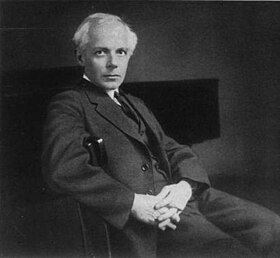Béla Bartók
Béla Bartók (b. Nagyszentimiklós, Hungary, 25 March 1881; d. New York City 26 September 1945) was a famous Hungarian composer and pianist. He was one of the most important and original composers of the 20th century. He became very interested in folk music and travelled a lot in Hungary and other countries, including Romania, listening to the folk songs which the country people sang. He often used the style of these songs in his music. He is famous for his piano music, string quartets and several pieces for orchestra including one called Concerto for Orchestra. Bartók’s harmonies and lively rhythms were sometimes quite new to classical music and some audiences found them difficult to understand at first.

Childhood and early years
changeBéla Bartók was born in the small town of Nagyszentmiklós. In those days it was in the Austro-Hungarian Empire, but today it is in Romania. When he was very small he showed great musical talent, and his mother taught him to play the piano.
Béla was often ill when he was a child. When he was seven his father died, and his mother took him and his sister to live in Nagyszőlős (today it is called Vinogradiv and is in Ukraine), and then to Pozsony (today it is Bratislava in Slovakia). There he gave his first public recital when he was eleven. He included some music which he had composed himself.
Early musical career
changeSoon he was studying the piano with István Thoman who had studied with the famous Franz Liszt. He had lessons in composition from János Koessler at the Royal Academy of Music in Budapest. There he met the composer Zoltán Kodály, who was a great influence on him and who became a lifelong friend.
He soon started to compose longer pieces of music. He liked the music of Richard Strauss and Claude Debussy and these influenced his style of music. He started to be interested in folk music. This can be heard in the first of his six string quartets.
Bartók and Kodály travelled together into the countryside to collect and study old Hungarian folk melodies. People in those days thought that real Magyar (old Hungarian) folk music was Gypsy music. Bartók and Kodály showed that there were other traditions beside these. They found music which used pentatonic scales similar to those used in some parts of Asia. The two composers started to use these folk ideas in their own compositions. Kodály often quoted (copied) actual folk songs in his own music, while Bartók preferred to compose music which sounded like folksong without actually copying it.
Middle years and career
changeIn 1909, Bartók married Márta Ziegler. Their son, also named Béla, was born in 1910.
In 1911, Bartók wrote his only opera, Bluebeard's Castle. There are only two singers in the opera: Bluebeard and his wife Judith. He also wrote a ballet called The Wooden Prince. This started to make him famous abroad. Another ballet, The Miraculous Mandarin, is even more famous today. It shows the influence of Igor Stravinsky, Arnold Schoenberg, as well as Richard Strauss. He wrote a lot of chamber music including a total of 6 string quartets, 2 violin sonatas and a Sonata for Two Pianos and Percussion. He wrote some pieces for smaller orchestras: Divertimento for strings and Music for Strings, Percussion and Celesta.
Bartók divorced Márta in 1923, and married a piano student, Ditta Pásztory. His second son, Péter, was born in 1924.
World War II and later career
changeWhen World War II broke out Bartók criticized the Nazis. After they came into power in Germany, he refused to give concerts there and did not use his German publisher. His political ideas gave him a great deal of trouble in Hungary.
Having first sent his manuscripts out of the country, Bartók felt he had to emigrate to the USA with Ditta Pásztory. They lived in New York City. Their son Péter joined them in 1942 and later joined the United States Navy. Bartók ‘s older son Béla stayed in Hungary.
Bartók did not feel comfortable in the US, and found it very difficult to compose. He was also not very well known in America, and not many people were interested in his music. He and his wife Ditta gave concerts, and for a while, they were given some money to work on a collection of Yugoslav folk songs. They did not have very much money, although he had some friends who gave them enough to live on. Serge Koussevitsky asked him to write the Concerto for Orchestra . This soon became Bartók's most popular work, and brought him some money. He was also asked by Yehudi Menuhin to write a Sonata for Solo Violin. This seemed to make him interested again in composing, and he went on to write his Piano Concerto No. 3 and began work on his Viola Concerto.
Bartók died by polycythemia in New York City from on 26 September 1945, aged 64. He left the Viola Concerto unfinished at his death; it was later finished by his pupil Tibor Serly.
Music
changeBartók’s music has many modern techniques such atonality, bitonality and modern harmonies. He often uses different kinds of scales (not just major and minor ones), and very complicated rhythms. A lot of these are inspired by the folk music he heard. He wrote a lot of piano music, including some easy pieces for people who are learning the piano. This includes a collection of pieces in six volumes called Mikrokosmos which are very popular with young musicians today.